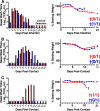Airborne transmission of highly pathogenic H7N1 influenza virus in ferrets
- PMID: 24696487
- PMCID: PMC4054360
- DOI: 10.1128/JVI.02765-13
Airborne transmission of highly pathogenic H7N1 influenza virus in ferrets
Abstract
Avian H7 influenza viruses are recognized as potential pandemic viruses, as personnel often become infected during poultry outbreaks. H7 infections in humans typically cause mild conjunctivitis; however, the H7N9 outbreak in the spring of 2013 has resulted in severe respiratory disease. To date, no H7 viruses have acquired the ability for sustained transmission among humans. Airborne transmission is considered a requirement for the emergence of pandemic influenza, and advanced knowledge of the molecular changes or signature required for transmission would allow early identification of pandemic vaccine seed stocks, screening and stockpiling of antiviral compounds, and eradication efforts focused on flocks harboring threatening viruses. Thus, we sought to determine if a highly pathogenic influenza A H7N1 (A/H7N1) virus with no history of human infection could become capable of airborne transmission among ferrets. We show that after 10 serial passages, A/H7N1 developed the ability to be transmitted to cohoused and airborne contact ferrets. Four amino acid mutations (PB2 T81I, NP V284M, and M1 R95K and Q211K) in the internal genes and a minimal amino acid mutation (K/R313R) in the stalk region of the hemagglutinin protein were associated with airborne transmission. Furthermore, transmission was not associated with loss of virulence. These findings highlight the importance of the internal genes in host adaptation and suggest that natural isolates carrying these mutations be further evaluated. Our results demonstrate that a highly pathogenic avian H7 virus can become capable of airborne transmission in a mammalian host, and they support ongoing surveillance and pandemic H7 vaccine development.
Importance: The major findings of this report are that a highly pathogenic strain of H7N1 avian influenza virus can be adapted to become capable of airborne transmission in mammals without mutations altering receptor specificity. Changes in receptor specificity have been shown to play a role in the ability of avian influenza viruses to cross the species barrier, and these changes are assumed to be essential. The work reported here challenges this paradigm, at least for the influenza viruses of the H7 subtype, which have recently become the focus of major attention, as they have crossed to humans.
Copyright © 2014, American Society for Microbiology. All Rights Reserved.
Figures







Comment in
-
Sequence changes associated with respiratory transmission of H7N1 influenza virus in mammals.J Virol. 2014 Jun;88(12):6533-4. doi: 10.1128/JVI.00886-14. Epub 2014 Apr 2. J Virol. 2014. PMID: 24696481 Free PMC article. No abstract available.
-
An avian H7N1 gain-of-function experiment of great concern.mBio. 2014 Oct 14;5(5):e01882-14. doi: 10.1128/mBio.01882-14. mBio. 2014. PMID: 25316697 Free PMC article.
-
The decision to publish an avian H7N1 influenza virus gain-of-function experiment.mBio. 2014 Oct 14;5(5):e01985-14. doi: 10.1128/mBio.01985-14. mBio. 2014. PMID: 25316699 Free PMC article. No abstract available.
References
-
- Palese P, Shaw ML. 2007. Orthomyxoviridae: the viruses and their replication, p 1648–1692 In Knipe DM, Howley PM. (ed), Fields virology, 5th ed, vol 1 Lippincott Williams and Wilkins, Philadelphia, PA
-
- Fouchier RA, Schneeberger PM, Rozendaal FW, Broekman JM, Kemink SA, Munster V, Kuiken T, Rimmelzwaan GF, Schutten M, Van Doornum GJ, Koch G, Bosman A, Koopmans M, Osterhaus AD. 2004. Avian influenza A virus (H7N7) associated with human conjunctivitis and a fatal case of acute respiratory distress syndrome. Proc. Natl. Acad. Sci. U. S. A. 101:1356–1361. 10.1073/pnas.0308352100 - DOI - PMC - PubMed
-
- Koopmans M, Wilbrink B, Conyn M, Natrop G, van der Nat H, Vennema H, Meijer A, van Steenbergen J, Fouchier R, Osterhaus A, Bosman A. 2004. Transmission of H7N7 avian influenza A virus to human beings during a large outbreak in commercial poultry farms in the Netherlands. Lancet 363:587–593. 10.1016/S0140-6736(04)15589-X - DOI - PubMed
-
- Belser JA, Davis CT, Balish A, Edwards LE, Zeng H, Maines TR, Gustin KM, Martinez IL, Fasce R, Cox NJ, Katz JM, Tumpey TM. 2013. Pathogenesis, transmissibility, and ocular tropism of a highly pathogenic avian influenza A (H7N3) virus associated with human conjunctivitis. J. Virol. 87:5746–5754. 10.1128/JVI.00154-13 - DOI - PMC - PubMed
Publication types
MeSH terms
Grants and funding
LinkOut - more resources
Full Text Sources
Other Literature Sources
Medical
Molecular Biology Databases
Miscellaneous

